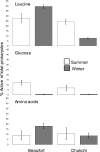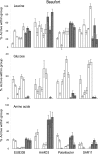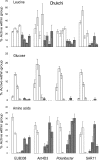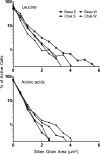Abundance and single-cell activity of heterotrophic bacterial groups in the western Arctic Ocean in summer and winter
- PMID: 22286998
- PMCID: PMC3302604
- DOI: 10.1128/AEM.07130-11
Abundance and single-cell activity of heterotrophic bacterial groups in the western Arctic Ocean in summer and winter
Abstract
Environmental conditions in the western Arctic Ocean range from constant light and nutrient depletion in summer to complete darkness and sea ice cover in winter. This seasonal environmental variation is likely to have an effect on the use of dissolved organic matter (DOM) by heterotrophic bacteria in surface water. However, this effect is not well studied and we know little about the activity of specific bacterial clades in the surface oceans. The use of DOM by three bacterial subgroups in both winter and summer was examined by microautoradiography combined with fluorescence in situ hybridization. We found selective use of substrates by these groups, although the abundances of Ant4D3 (Antarctic Gammaproteobacteria), Polaribacter (Bacteroidetes), and SAR11 (Alphaproteobacteria) were not different between summer and winter in the Beaufort and Chukchi Seas. The number of cells taking up glucose within all three bacterial groups decreased significantly from summer to winter, while the percentage of cells using leucine did not show a clear pattern between seasons. The uptake of the amino acid mix increased substantially from summer to winter by the Ant4D3 group, although such a large increase in uptake was not seen for the other two groups. Use of glucose by bacteria, but not use of leucine or the amino acid mix, related strongly to inorganic nutrients, chlorophyll a, and other environmental factors. Our results suggest a switch in use of dissolved organic substrates from summer to winter and that the three phylogenetic subgroups examined fill different niches in DOM use in the two seasons.
Figures






Similar articles
-
Winter-to-summer changes in the composition and single-cell activity of near-surface Arctic prokaryotes.Environ Microbiol. 2008 Sep;10(9):2444-54. doi: 10.1111/j.1462-2920.2008.01674.x. Epub 2008 Jun 28. Environ Microbiol. 2008. PMID: 18557769
-
Seasonal variations in the contributions of different bacterial groups to the uptake of low-molecular-weight compounds in northwestern Mediterranean coastal waters.Appl Environ Microbiol. 2007 Jun;73(11):3528-35. doi: 10.1128/AEM.02627-06. Epub 2007 Mar 30. Appl Environ Microbiol. 2007. PMID: 17400772 Free PMC article.
-
A metaproteomic assessment of winter and summer bacterioplankton from Antarctic Peninsula coastal surface waters.ISME J. 2012 Oct;6(10):1883-900. doi: 10.1038/ismej.2012.28. Epub 2012 Apr 26. ISME J. 2012. PMID: 22534610 Free PMC article.
-
Strong Seasonality in Arctic Estuarine Microbial Food Webs.Front Microbiol. 2019 Nov 29;10:2628. doi: 10.3389/fmicb.2019.02628. eCollection 2019. Front Microbiol. 2019. PMID: 31849850 Free PMC article. Review.
-
Ecology of southern ocean pack ice.Adv Mar Biol. 2002;43:171-276. doi: 10.1016/s0065-2881(02)43005-2. Adv Mar Biol. 2002. PMID: 12154613 Review.
Cited by
-
Exploring bacterial diversity in Arctic fjord sediments: a 16S rRNA-based metabarcoding portrait.Braz J Microbiol. 2024 Mar;55(1):499-513. doi: 10.1007/s42770-023-01217-6. Epub 2024 Jan 4. Braz J Microbiol. 2024. PMID: 38175355
-
Science Objectives for Flagship-Class Mission Concepts for the Search for Evidence of Life at Enceladus.Astrobiology. 2022 Jun;22(6):685-712. doi: 10.1089/ast.2020.2425. Epub 2022 Mar 15. Astrobiology. 2022. PMID: 35290745 Free PMC article.
-
Particle Collection in Imhoff Sedimentation Cones Enriches Both Motile Chemotactic and Particle-Attached Bacteria.Front Microbiol. 2021 Apr 1;12:643730. doi: 10.3389/fmicb.2021.643730. eCollection 2021. Front Microbiol. 2021. PMID: 33868201 Free PMC article.
-
Comparison of Two 16S rRNA Primers (V3-V4 and V4-V5) for Studies of Arctic Microbial Communities.Front Microbiol. 2021 Feb 16;12:637526. doi: 10.3389/fmicb.2021.637526. eCollection 2021. Front Microbiol. 2021. PMID: 33664723 Free PMC article.
-
Mesozooplankton taurine production and prokaryotic uptake in the northern Adriatic Sea.Limnol Oceanogr. 2020 Nov;65(11):2730-2747. doi: 10.1002/lno.11544. Epub 2020 Jun 25. Limnol Oceanogr. 2020. PMID: 33664530 Free PMC article.
References
-
- Abell GC, Bowman JP. 2005. Ecological and biogeographic relationships of class Flavobacteria in the Southern Ocean. FEMS Microbiol. Ecol. 51:265–277 - PubMed
-
- Alonso-Sáez L, Sanchez O, Gasol JM, Balague V, Pedrós-Alió C. 2008. Winter-to-summer changes in the composition and single-cell activity of near-surface Arctic prokaryotes. Environ. Microbiol. 10:2444–2454 - PubMed
Publication types
MeSH terms
Substances
LinkOut - more resources
Full Text Sources


